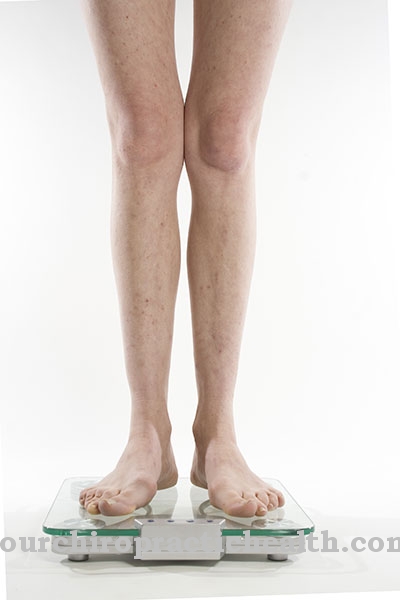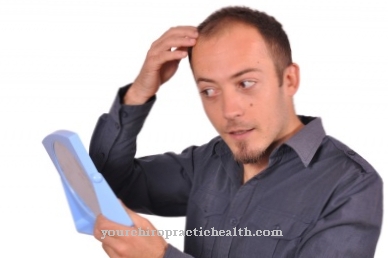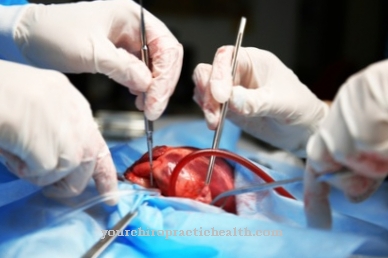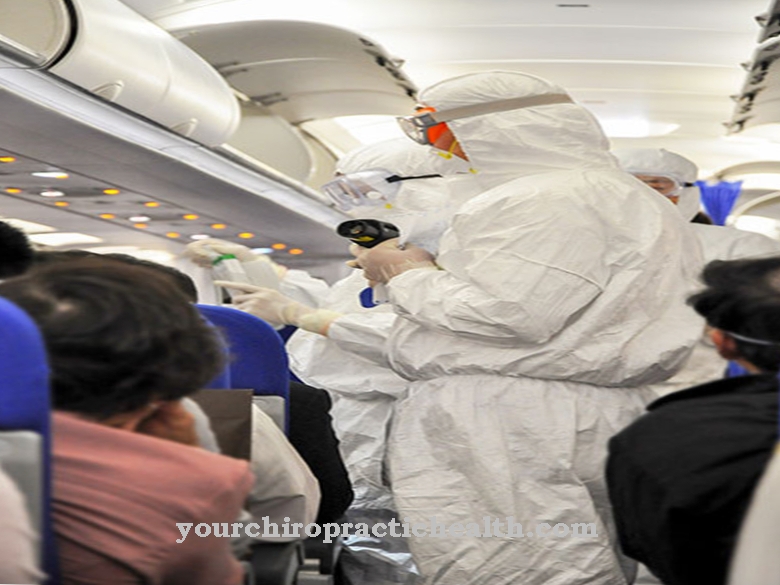As Athetosis is called a movement disorder. It is one of the hyperkinesias.
What is athetosis?

© bilderzwerg - stock.adobe.com
Doctors understand athetosis to be a form of movement disorder. She belongs to the group of extrapyramidal hyperkinesias on. The affected people suffer from slow and uncontrolled movements in their limbs that are screw-like.
The hands are particularly affected. Most patients also develop chorea. This is a movement of restlessness that is associated with involuntary, rapid muscle contractions. In medicine, this process is known as choreaathetosis.
Athetosis is most common in children. A typical feature of the movement disorder are bizarre misalignments that alternate. In addition, there is an unnatural overstretching of the joints.
Athetosis can occur on only one side of the body, which is known as hemiathetosis, and on both halves of the body (athetosis double). Some experts only call athetosis distal dystonia or slow chorea considered. In most cases, the movement disorder is accompanied by other neurological symptoms.
causes
Athetosis and chorea are caused by damage to the basal ganglia pallidum and striatum. Basal ganglia are nuclei from the gray matter of the brain. They are located under the cerebral cortex. Their main function is to regulate motor skills. The striatum (striped body) is composed of the tail nucleus (nucleus caudatus) and the outer lens nucleus (putamen).
Brain damage that results in athetosis already takes place in early childhood. A common cause is bilirubin encephalopathy (kernicterus). In the central nervous system of babies, there is considerable damage due to an above-average increase in bilirubin, which is a breakdown substance for the red blood pigment. Another early childhood trigger is Little's disease. This severe damage to the brain occurs before or during the birth.
Possible reasons for this are complications during pregnancy, infections that involve the brain, vascular occlusions in the brain region, or a lack of oxygen. But athetosis can also occur in adults. This is mostly a hemiathetosis. It is caused by a nuclear attack, a special type of stroke. This comes about through a spontaneous reduction in blood flow to the pallidum and putamen.
You can find your medication here
➔ Medicines for paresthesia and circulatory disordersSymptoms, ailments & signs
The main feature of athetosis is a disorder of tonic coordination. This leads to hyperkinetic motion sequences. The patient exercises uncontrolled, slow and twisting movements on his hands, arms and legs as well as on the trunk. The body's movements are involuntary. Muscle twitching also occurs. Attention and psychological excitement intensify the agitation. On the other hand, there are usually no restless movements when sleeping.
The movements often have a helical shape and are random. The hands, neck and face are severely affected. Typical symptoms are spreading the fingers, grimacing and twisting the mouth as well as overstretching the hands, which seem bizarre.
Other abnormalities are a cramped posture of the neck, turning movements with the head and increased salivation. The patient walks stumbling and overshooting. It is not uncommon for a combination of athetosis and spasticity to occur. In some joints, there is a risk of dislocation (dislocation) due to excessive mobility.
Diagnosis & course
If a child is suspected of having athetosis due to motor abnormalities or bizarre hand misalignments, a doctor should be consulted. The same goes for adults who notice unusual movement disorders in themselves.
The first step in the diagnosis is to review the patient's medical history. The parents of the child are asked about the symptoms and possible previous illnesses. After that, the doctor will do a physical exam.
He also uses imaging methods to look for possible damage to the brain that could be responsible for the movement disorder. Depending on the cause of the athetosis, further investigations are conceivable.
In the further course, athetosis often leads to communicative misunderstandings in children, which are caused by speech disorders as well as involuntary gestures and facial expressions. As a result, emotional disorders in the child are conceivable. In addition, sensorimotor development is delayed, which means that those affected can walk late or only with aids.
Complications
Athetosis has a very negative effect on the patient's everyday life and can limit his life to a relatively large extent. This leads to very fast and uncontrolled movements that the patient cannot control himself. This can lead to severe problems, especially with children, as they are bullied or teased because of the athetosis.
In this case, depression and other psychological limitations occur. The everyday life of the person affected is restricted by athetosis and many activities cannot be carried out. In addition to the movements, there is often an uncontrolled flow of saliva and bizarre movements or hyperextension of the limbs. Due to the athetosis, the patient can involuntarily dislocate his joints or limbs.
A direct treatment is not possible in athetosis, so there are no further complications. However, it is possible to restrict the bizarre movements and also to control and calm the breathing of the person concerned. Certain therapies can also treat social problems so that there are no complaints or problems in old age.
However, athetosis does not have a negative effect on life expectancy. However, children with athetosis in particular need special treatment in order not to be socially excluded.
When should you go to the doctor?
In the case of athetosis, a doctor must be consulted in any case. This disease does not self-heal and those affected are definitely dependent on medical treatment. Without treatment, the joints may be overstretched or dislocated. As a rule, involuntary movements and twitching of the muscles or joints are symptoms of athetosis and should be examined. Cramps and pain can also occur in the affected regions.
It is not uncommon for those affected to suffer from athetosis from attention and concentration disorders and, for example, cannot follow lessons. A doctor should also be consulted if the hands or legs are overstretched. Increased salivation is also a symptom of athetosis and must be examined by a doctor. It is not uncommon for those affected to suffer from various spasticity and thus significant restrictions in their lives. First and foremost, the general practitioner can be consulted for the diagnosis. The further treatment of the individual complaints is then carried out by an appropriate specialist.
Doctors & therapists in your area
Treatment & Therapy
There are only limited options available for treating athetosis. The primary goal of therapy is to change posture control by controlling involuntary movements. At the same time, it is important to improve the patient's breathing and to support his communication. It is also important to promote locomotion, whereby aids can also be used, and to facilitate food intake. Furthermore, sensorimotor and emotional-social consequential damage should be prevented.
Physiotherapy exercises are considered the best method to combat the movement disorder. This primarily includes the so-called Bobath method. The Bobath concept was developed in 1943 by the German physiotherapist Berta Bobath (1907-1991) and her husband, a neurologist, especially for children and adults suffering from neurological diseases.
The method includes special exercises that are used to learn natural postures and movements. Some patients also receive drug therapy. Preparations such as clonazepam, haloperidol and tiapride are administered. In this way, a positive influence on athetosis should be achieved.
Outlook & forecast
The prognosis for athetosis is not very optimistic. A recovery of the symptoms does not occur with the disease. According to the current state of science, the brain damage cannot be cured. However, symptom relief is possible in some areas and practiced successfully.
The extent of the improvement is individual and depends on the severity of the disease. Physiotherapy, nutritional advice and psychotherapy are usually included in the treatment plan. Strengthening the muscles and training movement sequences helps to experience improved well-being in everyday life. With a healthy and optimally balanced diet, an increase in the quality of life can also be observed in the patient. It is tailored to the needs of the body and thus to those of the muscles and the immune system.
Emotional and spiritual issues are dealt with by a therapist. As the life span is shortened with athetosis, there is a threat of social exclusion and depression often develops, therapeutic support helps in coping with and processing the circumstances in everyday life.
In addition, a restructuring of the domestic situation is helpful to strengthen the well-being. Targeted exercises and aids that promote learning of natural postures and movement sequences help the patient cope with everyday life. In addition, the drug treatment brings about relief from some symptoms.
You can find your medication here
➔ Medicines for paresthesia and circulatory disordersprevention
There are no known measures that serve to prevent athetosis. It is all the more important to start therapy quickly as soon as the first signs of the movement disorder appear.
Aftercare
Athetosis requires lengthy therapy, which is usually followed by several years of follow-up care. In many cases, a causal treatment is not possible because the damage to the brain stems is permanent. Follow-up care focuses on regular follow-up checks, with the responsible neurologist or orthopedist performing various ultrasound examinations and brain scans.
This allows the state of health to be determined exactly and treatment to be optimized. Aftercare also includes extensive physiotherapy. This treatment often has to be continued for years, depending on whether the athetosis continues and which areas of the brain are affected in the course of the disease. Follow-up care also includes patient discussions.
Depending on the severity of the disease, these can take place every four to eight weeks or every six months. In the case of a severe course of the disease, the doctor will use the patient talks to find possible causes for the progressively worsening symptoms. Since athetosis can have very different effects, follow-up care always depends on the patient's individual state of health.
Basically, brain scans, patient discussions, bone and joint examinations as well as physiotherapeutic measures are carried out. In addition, the medication must be checked and, if necessary, adjusted to ensure optimal healing of the athetosis.
You can do that yourself
Since athetosis is incurable, those affected are forced to come to terms with the disease. The earlier this happens, the better it can be dealt with. This is where self-help groups have proven to be helpful, in which patients exchange their experiences and everyday tips. Furthermore, special physiotherapy exercises provide relief. These keep ligaments, muscles and joints supple.
They also improve posture and breathing. Some of the supported movement patterns can also be carried out at home. The so-called Bobath method, which focuses on special movement exercises in which, of course, posture and movement patterns are newly learned is particularly suitable.
A balanced and as relaxed lifestyle as possible - in terms of diet and the course of the day - are also indicated. Since movements are difficult to carry out, the living situation should be adapted accordingly (keyword stairs). Any aids can also be requested from the health insurance company. The demand there is definitely worthwhile.
Contact with other affected persons, but also with encouraging people from the normal environment helps against emerging depression. A big mistake would be withdrawing from life and self-chosen isolation. This would only cause those affected to concentrate exclusively on their illness and have little joy in life.



.jpg)




















.jpg)



